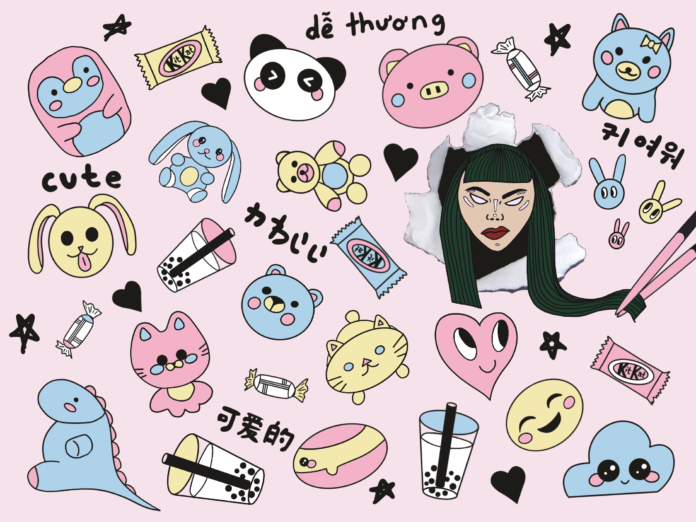Images and videos courtesy Deutsch LA
By Corrie Martin
The Against Asian Hate collection that recently debuted on the NFT marketplace is clever, poignant, and often hilarious.
The unique digital art exhibition on Rarible.com comprises seven newly “minted” digital artworks by a diverse group of AAPI artists. The collection conveys a story that “juxtaposes the way America takes from Asian culture with the lack of support America offers when it comes to uplifting, protecting, and fighting for equality within Asian American communities.”
LATEST STORIES
Against Asian Hate is the brainchild of the Asian Employees Resource Group at the advertising agency Deutsch LA, the company behind the memorable 1997 Ikea television commercial that featured the first openly gay couple.
“Back then there was a wide variety of passionate reactions around the campaign, and the Ikea commercial was groundbreaking and marked a pivotal moment for the industry,” Autumn Drummond, Deutsch LA public relations specialist tells AsAmNews. “Our Against Asian Hate collection is an exciting expression of that same mission to use storytelling as a means to push humanity forward.”
Spearheading the project is Angie Kang, an Experience Designer at Deutsch LA who is also an artist and accomplished songwriter and musician who has previously toured with her own punk rock band.
“My colleagues at Deutsch LA were deeply shaken by the Atlanta shootings. We had been mulling over wanting to do something about anti-Asian racism for months, but then the shooting really galvanized us. We actually pulled the collection together and finalized our partnership with the organization Stop AAPI Hate in about 2 weeks!” she said.
An experienced e-commerce entrepreneur and designer of apps and websites, Kang had to teach herself the technology and ins-and-outs of the emerging NFT marketplace as she guided the project from concept to digital reality. Still avant-garde as a medium in the marketplace of art collecting, “NFT” (“nonfungible token”) blockchain technology makes it possible for a digital file like an image, gif, meme, video, or audio clip to exist as a singular, unique object, much like an original print photograph that is otherwise in theory and practice infinitely reproducible.
One piece of artwork in the collection–what appears to be a photographic image of the ubiquitous white plastic takeaway bag–seems to have no pretense at all as a work of high art. “You’re Welcome,” minted by Filipino American filmmaker, storyteller, actor, artist JJ Augustavo, is in fact a brilliant visual lashing of anti-Asian racism.
The image is of a common, white plastic take-out food bag typical of Asian food restaurants, but with the familiar litany of “Thank Yous” printed in red replaced with an ironic “You’re Welcome” in multiple languages such as Chinese, Japanese, Thai, Viet, Filipino and Korean.
“I wanted to make an art piece that spoke to how we as Asian Americans have been the target of threats, violence, the most vile treatment, while no one seems to care or treat us like Americans or better yet as humans,” Augustavo told AsAmNews.
His piece is no simple riff on Andy Warhol, famous for transforming everyday, mass-produced commercial objects into wry social satire. Augustavo ingeniously turns the ubiquitous plastic take-out bag into a symbol of the dehumanized utility and disposabiilty of Asian Americans in a White supremacist society.
“We make your food, sew your clothes, deliver your mail, or take care of your grandma in the hospital, but we’re not seen as real people deserving of acknowledgement or appreciation as part of the fabric of this country,” Augustavo said. “And we’re the ones expected to always say, ‘thank you’ no matter how we’re mistreated. I wanted to find a way short of literally saying ‘f*ck you,’ so I made something that said that in a ‘cleaner’ way.”
The piece also includes fine print at the bottom of the bag where safety warnings and admonishments to recycle are normally found. In their place, Augustavo has printed the statement, “More than food, more than workers, we are human,” followed by this famous quote from America Is in the Heart, an iconic text of Asian American literature by Filipino American poet, writer, activist Carlos Bulosan:
“WE ARE ALL THAT NAMELESS FOREIGNER, THE HOMELESS REFUGEE, THAT HUNGRY BOY, THAT ILLITERATE
IMMIGRANT AND THAT LYNCHED BLACK BODY. ALL OF US, FROM THE FIRST ADAMS TO THE LAST FILIPINO, NATIVE
BORN OR ALIEN, EDUCATED OR ILLITERATE — WE ARE AMERICA!”
While Augustavo’s piece invites the viewer to zoom in, look closer, and dig deeper into its layers of meaning, other pieces in the collection are animated, taking several seconds to unfold. One such piece, “Why Isn’t This $6?” by designer, writer, illustrator Stacy Nguyen is an animated cartoon that skewers the hypocrisy and racism of the White consumer.
Nguyen tells AsAmNews that her piece “is about the tendency to devalue ‘ethnic’ (aka non-Western, non-white) foods. It was something I heard often growing up and hear often now — people balking when they have to pay more than a nominal amount for Asian food. Yet the same people think nothing of spending a lot of money for Italian food or hipster burgers. People seriously expect banh mi sandwiches to cost a few bucks and they seriously expect their bowls of pho to cost around $6 bucks.”
In her piece, a bowl of pho is turned upside down after a presumably White customer complains about its price.
“We don’t spend enough time examining why we want non-white small business owners to work their asses off and toil super hard for microscropic profit margins,” explains Nguyen. “We don’t think about our secret biases and internalized racism, when we assign different values to different cuisine types.”
Kang tells AsAmNews that one of her favorite pieces is the animated illustration, “Aisle of Dreams,” by Hiromi Yamamura and Christopher Cordingley.
“The piece is based on a childhood memory of the artist walking down the toy aisle of a big store with her mother and sister, and how nothing on the shelves reflected her own or her family’s identity. The slow pacing of the trio walking down the aisle feels haunting and sad, while at the same time I feel the love and history there between the mother and daughters holding hands and moving together,” she said.
Kang’s emotional reaction to the pieces are not surprising given their themes and the motivations of the artists. That a digital work of art can spark such emotions from viewers should also not surprise us, nor should the urge to buy, collect, and re-sell such pieces. “Collecting is a human fascination,” Kang notes, “and NFTs now allow us to collect and confer value upon our digital creations.”
The idea that bits of code and blips of light on a screen constitute an object or thing as concrete and collectible as a painting or sculpture might still mystify a lot of people. Others are wary that NFTs are just the latest form of technocapitalism, the latest scam to monetize anything and everything.

On the other hand, Nguyen says, “I think NFTs have the potential to make art more equitable and accessible, where artists no longer have to go through traditional white-led and white-dominated processes of getting representation and being shown in a gallery to sell their art to collectors. I’m really excited to see how this evolves.”
NFT technology allows artists to specify conditions of reproducibility and to control their unique creation, Nguyen believes.
“I also can see this empowering artists because so often in digital spaces, it’s not that hard for people to just rip off and make a copy of our work and resell it for profit. That’s happened to me before. I think NFTs could be part of a larger culture shift in how we see and value digital art.”
Augustavo thinks that NFTs have radical potential for unleashing creative expression. “I believe we are just scratching the surface of what these can do,” he said.
“I see NFTs as an interesting new tool to spread story and voice. No different than the work of Kara Walker, Ai Wei Wei or even renaissance artists. NFTs can allow the viewer to make up their mind about what the story or meaning is without forceful guidance. You follow the brush strokes and gazes of subjects on a painting to follow and create your own narrative, or the heightened nature of a lily pad to create a feeling of that moment in time. With NFTs you can do this and so much more. As an artist you can really be as subtle or forceful as you want because the guidelines are limitless, whereas a movie or song can be so contained and specific.”
As anti-Asian violence proceeds unabated nationally, Asian American art and artists respond with works that push directly against messaging such as from Harvard University’s Counseling and Mental Health Services in their recent attempt to cheer up their Asian and Asian American students by advising them to celebrate Asian culture and “seek out and create art highlighting the Asian community ‘in a positive light,’” as reported in the Harvard Crimson.
The contributing artists of the “Against Asian Hate” collection are rejecting this white-washing of their experiences with, and feelings about, systemic racism and individual acts of bigotry.
Instead of merely depicting “Asian” cultures and communities “in a positive light” as Harvard counseled their students, these artists are expressing rage and resistance, deploying their creativity and craft to provoke critical thinking, instigate collective action, and build community and solidarity.
Ultimately, the works included in Against Asian Hate stand out as collectible and meaningful. If they are celebratory, it’s that they celebrate the bottomless creativity and artistry of Asian American art and artists, and if they are “positive,” it’s in the sense that they are absolutely confident and clear about their mission and vision of art as a powerful tool and reflection of expression, emotion, and social action in the digital and “physical” realms.
“Asian American creative artists have always been at the heart of struggle against exclusion, denigration, degradation, stereotyping, attacks and racist expressions and actions of any kind because they have the courage and the vision to call out and fight back,” Evelyn Hu-DeHart, Professor of History and Ethnic Studies/Asian American Studies at Brown University, tells AsAmNews. “There would be no Asian American studies without the artists and writers among us.”
This proud tradition includes the digital art and artists among us now.
***
Buyers can bid on these one-of-a-kind, certifiably original digital art pieces, including an animated gif titled “Asian Sailor Moon” minted (created) by Kang, at the Against Asian Hate collection through April 23, 2021.
AsAmNews has Asian America in its heart. We’re an all-volunteer effort of dedicated staff and interns. Check out our new Instagram account. Go to our Twitter feed and Facebook page for more content. Please consider interning, joining our staff, or submitting a story or making a contribution.








